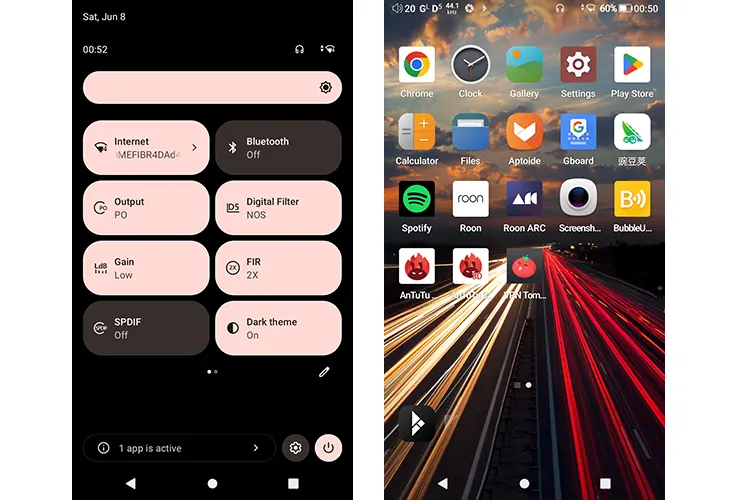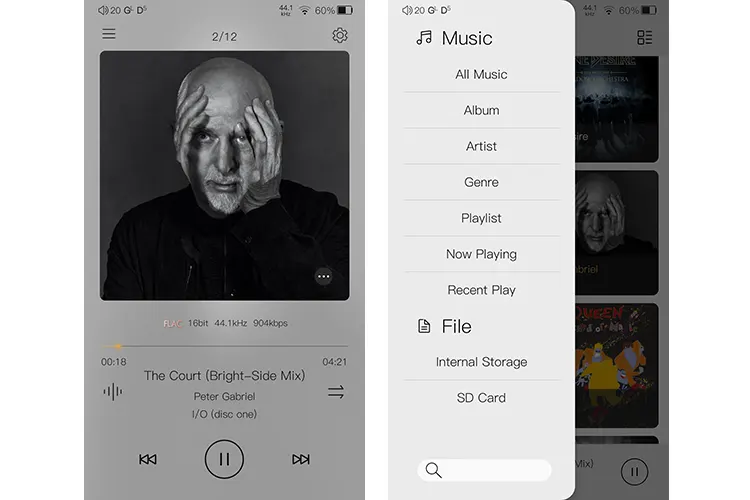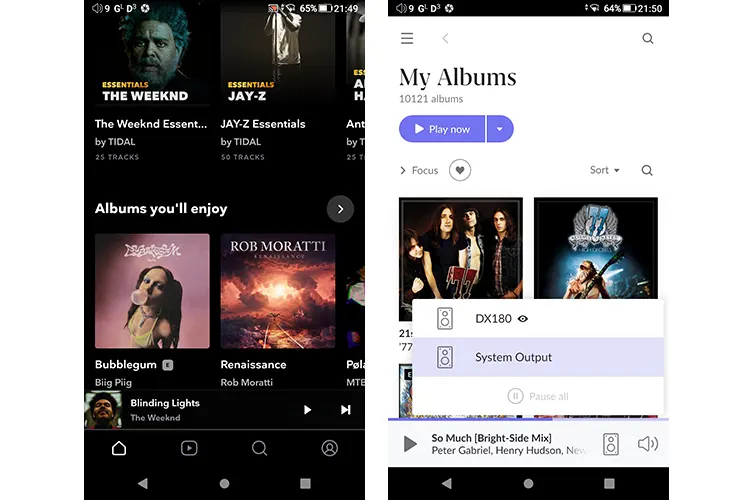Software Impressions
The following DX180 software impressions were completed using firmware v1.00.093. There is no dual-OS feature on this player.
Android 13
If you are coming from the Android 8 2GB DX160, even with the firmware bang up to date, it’s a million miles behind the Android 13 experience of the DX180.
And it is not just in terms of features and aesthetics. A quick dive into the CPU setup of the DX180 shows a much higher CPU Clock range of 300-2016 MHz compared to the 216- 1200 MHz of the DX160, meaning less throttling and more speed.
I never had the pleasure of using the DX170 but I highly doubt its RK3566 CPU, 2GB of RAM, and Android 11 OS would be a match for the 4GB, Android 13, and Snapdragon 665 Soc on the latest model.
Everything about the experience is subjectively faster. From booting up to quick navigation drop-down responsiveness and multiple windows being open simultaneously, the DX180 now feels much more competitive software-wise.
On a more practical level, Android 13 is more secure than the older editions with improved app compatibility which most will see as vital for 3rd party app loading. It also comes with Google Play out of the box which had to be installed manually before.
As with the DX3XX series, the DX180 also comes with an SRC bypass backed into the OS meaning you will receive a bitperfect output at a system level and applicable to almost every audio app you load on the device.
Performance Benchmarking
Though I do not have the FiiO M23 or HiBy R4 to hand, I believe the DX180 is one of the snappier midrange DAPs in the market today for CPU performance.
I used AnTuTu’s latest v10.2.6 benchmarking app for this test, which is much more taxing on these units than the older versions. It was quickly apparent how much more capable the DX180 was compared to the DX160 with the DX180 test starting 3-4 minutes after the DX160 and finishing much sooner.
The DX160 could not cope with v10.2.6 in 1080p or 720P mode and started to get quite hot and seriously slowed down around 60% into the test to the point where I had to call a halt.
Not that the DX180 is lightning fast, at least not compared to smartphones, but it is a significant step in the right direction for a midrange digital audio player.
Its final score of 237,480 in the above picture is higher than the FiiO M23’s score of 179,715 from the older AnTuTu V8.3.4, a DAP that uses Snapdragon 660, Android 10, and 4 GB of RAM.
The DX180 easily eclipses the sub-100k AnTuTu score produced by the HiBy R5 Gen 2 which uses a lower Snapdragon 425 Soc, Android 8, and 2 GB of RAM less.
The one DAP on par for CPU performance was the entry-level Android 13 HiBy Digital M300 with an AnTuTu score of 242,563. However, this is technically an entry-level DAP sound-wise.
Navigation
The DX180 is still a side-swipe screen flow UI with a drop-down menu rather than an App tray system. New apps will populate additional screens to the right with the ability to switch between 3-button or gesture-based swiping to navigate between apps.
The aesthetics and depth of options within the DX180 UI are vastly improved over the DX160. The better CPU performance also makes it less of a jerky experience.
The aesthetics and bubble-like shortcut options on the drop-down menu remind me a little of the HiBy R8 II‘s layout with its in-depth text labeling making it more intuitive to understand each shortcut’s intended function.
You also get a lot more shortcuts on the drop-down menu than before with a larger suite of filter modes and a system-wide 2-stage gain level feature that isn’t on the DX160 equivalent. And of course, you can access all this in dark mode which is almost a staple now on modern Android DAPs.
One omission is the lack of a double tap-to-wake option on the DX180. And yes, I did check in the settings menu. I eventually got used to not having it but it’s a hard habit to shake off.
Features
Mango App UI Refresh
If memory serves me correctly this version (3.7.7 ) of the Mango App is a 3rd generation design or refresh.
The options and features are much the same but it’s been given a modern makeover with a cleaner minimalist design and more gesture swiping for navigation.
Visually, I think it’s a lot nicer looking than the older version with enhanced media navigation options such as viewing artists similarly to how the album artwork is displayed.
The DX180’s improved CPU performance also makes scrolling smoother, with faster artwork refreshes than the DX160.
There are some navigational faux pas on the new DX180 Mango player App that will need to be tightened up in future firmware updates.
For example, the hamburger icon (3 lines) in the right corner of the playback screen takes you to “All Music” instead of the old media management home.
Here it gets slightly messy with an arrow in the top right of the All Music screen that intuitively makes you touch it thinking it takes you to the main media management menu. It takes you back to the playback screen instead.
Ignore the arrow and swipe from the left of the screen to get the media management menu. It would be better if the hamburger icon takes you directly to the menu alongside the gesture controls. It saves a navigational step and feels more intuitive.
The right-side playback menu on the playback screen is both a gesture and icon-based (cogwheel) system which has always been a feature of the Mango App.
However, unlike the older version, all of the app’s advanced options are on the same scrollable screen rather than on a secondary screen. That includes the USB-DAC and BT DAC controls as well as the environmental options such as display settings.
PEQ
No iBasso software feature set would be complete without mentioning their excellent PEQ system for the umpteenth time. Granted, many manufacturers have cottoned onto how great PEQ is with the likes of FiiO and HiBy now incorporating it into their players.
However, maybe it is just me but I find the Mango App version to be the most user-friendly. Although there is some dB attenuation when switching it on it’s not as drastic as the classic 10-band EQ alternative.
The PEQ system is a great leveler in my book. It can shape and adapt almost any headphone or IEM tuning to whatever you want them to sound like within reason. I think it’s better than many DSP presets because of how granular you can get with FR shaping.
Technically, the DX180 version has not changed from the older DX160 version in terms of mechanics and options. The only change is the theme, which is much brighter and more consistent with the new Mango App’s appearance.
WiFi Performance
Signal Strength
The measured data above is but a snapshot or milestone over 10 minutes. At times it was lower and higher for both DAPs. However, I found little difference between either DAP in terms of signal strength.
The DX180 WiFi signal strength was measured with a relatively weak modem signal here in the office. Hence the low percentage values in our screenshots above have more to do with the distance and performance of the modem.
Overall, the DX180 performance didn’t differ much for signal strength using the paired modem. Any minute percentage variance will be entirely down to the exact positioning of the DAP and the modem signal strength reliability which can vary at any given minute, at least for my modem.
One difference I did find is that the registered speed of the DX160 was at 5 Mbps which was much lower compared to the DX180’s 30 Mbps despite both using the 2.6Ghz signal, (channel 1o).
However, you will most likely find a bigger difference in the buffer when streaming, with the additional 2 GB of the DX180 making for a smoother streaming experience.
Streaming
The streaming options on the DX180 are as comprehensive as you might expect. The big 3rd party streaming apps are all available including TIDAL, Qobuz, Apple, and Spotify to name but a few via the pre-installed Google Play Store.
APK Pure is no longer a 3rd party APK installer on the DX180, it has been replaced by Aptoide which is a fairly comprehensive and safer APK library to install from. You should be able to get the region-locked apps such as TIDAL and Qobuz from Aptoide, then install and log in using a VPN app.
You can directly set up a DLNA service from your local network via apps such as BubbleUPnP or set the DX180 as a Roon Endpoint and remote access your Roon server over the web using Roon ARC.
Bluetooth Performance
This was a subjective test using two TWS in receiving mode with the DX180 as the main transmitter. That means I could test multiple codecs and how well the DX180 could cope over distances.
The three codecs tested were LDAC, SBC, and AAC with the first two tested with the Huawei Freebuds Pro 2 and AAC via a Status Between 3ANC TWS.
All 3 codecs did not show a huge difference in stability or range with all 3 meeting the minimal distance in the office which is about 10 meters with one wall between them.
Once I tried to turn the corner to go beyond the signal dropped which is where modern smartphones tend to do better with the same TWS devices.
If you plan to use the DX180 in your pocket and slip on some wireless headphones or TWS there shouldn’t be an issue. The signal was very stable for me during daily use with the DX180 not more than 1m to 2m away.
Wired Options
USB-DAC
The DX180 is plug-and-play for USB-DAC functionality so if you are using something similar to ROON it will show up immediately in your Audio Zone. For Windows and MAC platforms you should see it as a selectable sound profile option.
The device defaults to the universal 2.0 WASAPI drivers for USB-DAC on the PC, however, it also now has a dedicated USB receiver capable of supporting ASIO with a new BRAVO-HD downloadable driver package from the iBasso website.
You can control the filter settings and gain levels via the touchscreen which is more than what you can do on the DX160 DAC mode screen which has no options at all.
However, no bitrate/sample rate information and no ability to BT DAC transmit in USB-DAC mode are missing features that I would love to see iBasso incorporate into the Mango Player app.
OTG
I had no problems mounting flash drives on the DX180 via its USB-C port. I could see it via the Mango Player app’s media management side which has an OTG view option at the bottom of its side menu.
However, as with legacy Mango features from previous models, there is no way to directly integrate the metadata into the media library. It’s strictly seen as a folder-drill down which blunts the user experience.
You can use the stock DX180 USB-C cable for OTG Audio and it will work just fine. However, if you find it too long it will work with shorter alternative cables for OTG-compliant portable DAC/Amps.
I connected a short USB-C cable that comes with the Shanling H7 and H5 devices. I am pleased to say I had no issues connecting the Chord Electronics Mojo 2, the Shanling H5/H7, and the ONIX Mystic XP1 to the DX180 which might prove useful for those looking for more power or a different sonic flavor.
Click on page 3 below for my sound impressions and recommended pairings.










